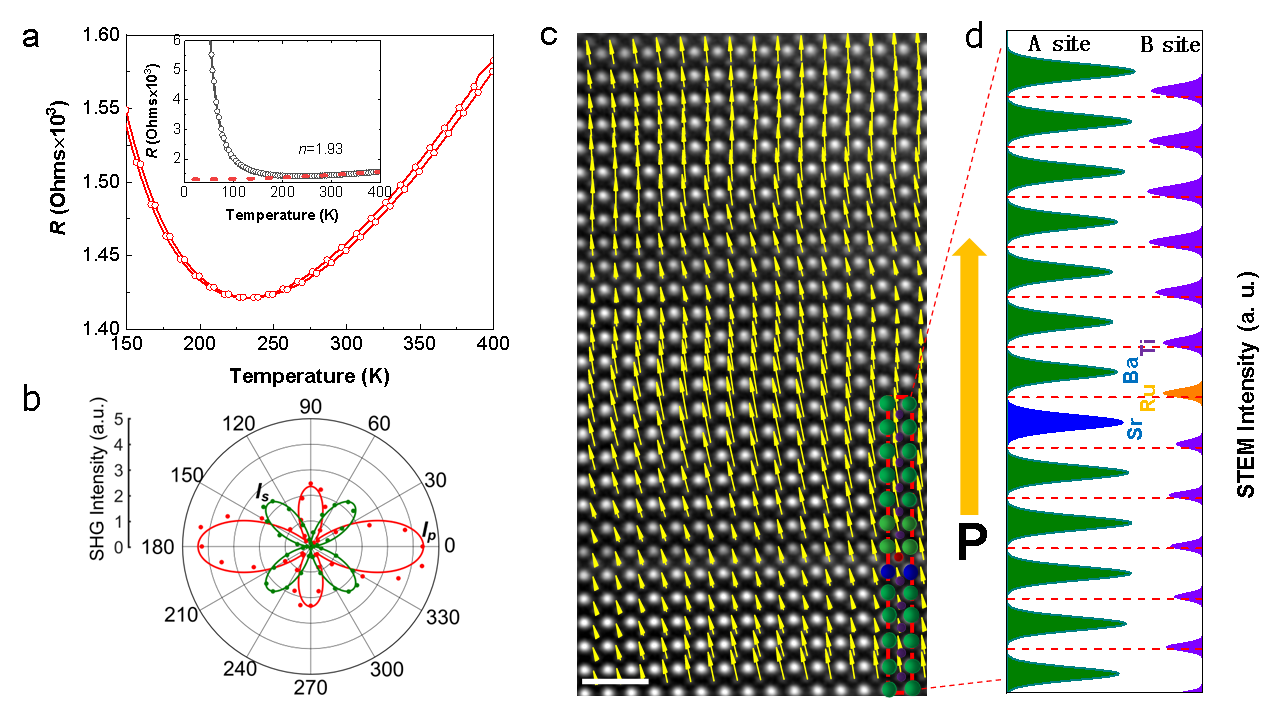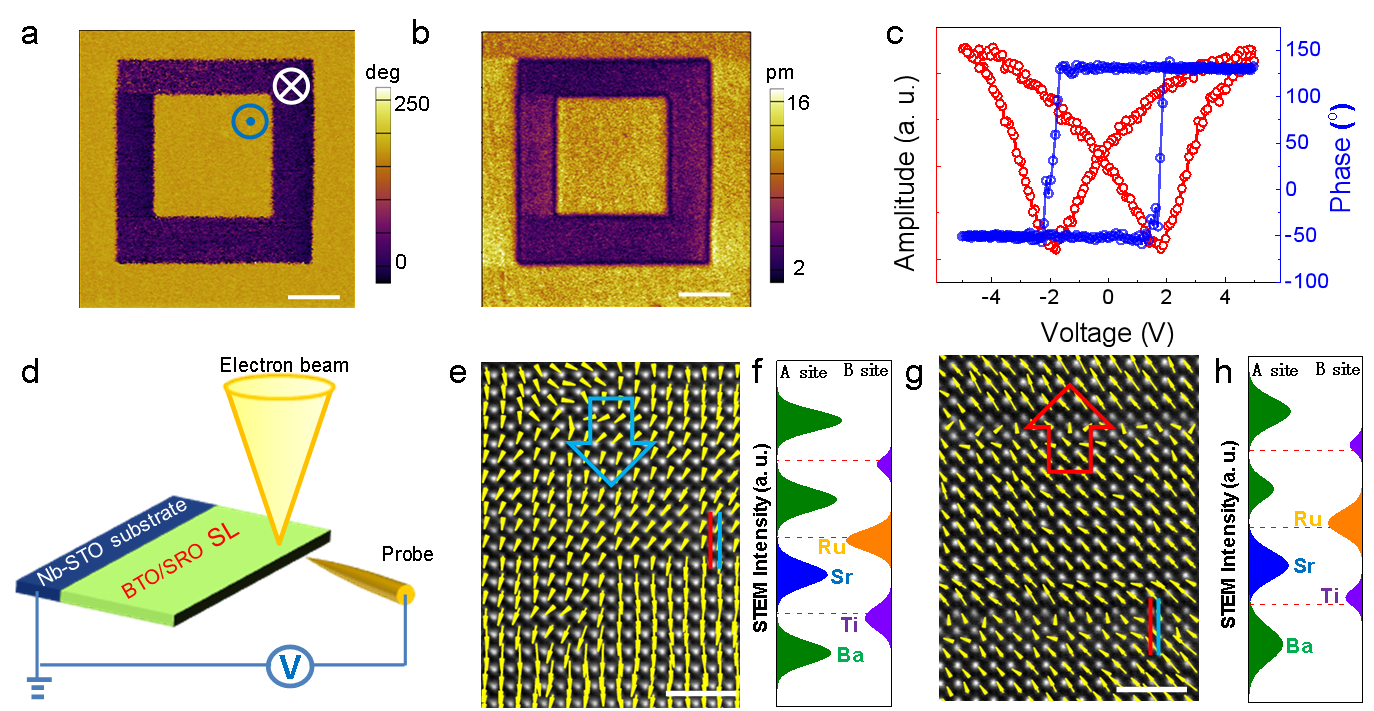SUSTech research team makes progress in two-dimensional ferroelectric metal
Mao Ye 2021-02-02
Recently, Professor Lang Chen’s lab at Southern University of Science and Technology (SUSTech) has made significant experimental progress in two-dimensional ferroelectric metal. The relevant results have been published in Nano Letters entitled “Electric Polarization Switching on an Atomically Thin Metallic Oxide”.

Ferroelectric metal possessing both ferroelectricity and metallicity, as an incredible paradigm of multiferroics, was introduced by Anderson and Blount over five decades ago. Since then, only a few polar metals have been identified. These non-centrosymmetric structures with metallicity are still not technically regarded as actual ferroelectrics, because the electric polarization cannot be switched by an external electric field. In this report, we demonstrate that a unit-cell thin polar metal can be stabilized and switched by ferroelectric polarization in the form of ferroelectric/unit-cell-thin metal superlattices, thereby forming a 2D ferroelectric metal.
We synthesized (SrRuO3)1/(BaTiO3)10 superlattices made of atomically thin SrRuO3 and ten-unit cells of traditional ferroelectric BaTiO3 by pulsed laser deposition. The fully-strained superlattices with an atomically sharp interface are obtained, which is characterized by both synchrotron XRD and high-resolution scanning transmission electron microscopy (HR-STEM).
 Figure 1. Structural characterization of the (SrRuO3)1/(BaTiO3)10 superlattices.
Figure 1. Structural characterization of the (SrRuO3)1/(BaTiO3)10 superlattices.
After the well-established crystal structure, we pay attention to the transport characteristics and polar displacement in the superlattices.
 Figure 2. Electrical transport properties and polar displacements in (SrRuO3)1/(BaTiO3)10 superlattices.
Figure 2. Electrical transport properties and polar displacements in (SrRuO3)1/(BaTiO3)10 superlattices.
It found that the superlattices are metallic, in which the electrons are confined in the monolayer Ru-O2 plane. The overall superlattices possess a net mm2 point group with an out-of-plane polarization, which clearly indicates polar structure in the superlattices. Moreover, a significant deviation of Ti and Ru atoms observed in the BaTiO3, and SrRuO3 layer, which demonstrates directly the polarization in the 2D metallic oxide layer. Further, the electric polarization switching of the superlattices are investigated through PFM, and in-situ STEM separately.
 Figure 3. The electric polarization switching of (SrRuO3)1/(BaTiO3)10 superlattices through PFM, and in-situ STEM, separately.
Figure 3. The electric polarization switching of (SrRuO3)1/(BaTiO3)10 superlattices through PFM, and in-situ STEM, separately.
A 180° phase contrast between the square domain patterns qualitatively demonstrates the appearance of the up and down polarization, respectively, which illustrates that a switchable polarization exists in the superlattices at room temperature. While PFM depicts the macroscopic polarization, TEM reveals the polarization on an atomic scale. The negative Ti deviation demonstrates a downward polarization for the BaTiO3 layer after being poled with Vtip= 10 V. Moreover, Ru ions, which form the metallic SrRuO3 layer, are forced to move downward as well. On the contrary, the downward polarized SrRuO3 can be switched upward by -10 V. Therefore, the polarization of an atomically thin metallic layer can be switched by an electric field at room temperature.
 Figure 4. Ferroelectric polarization and metallic conductivity predicted by density functional theory.
Figure 4. Ferroelectric polarization and metallic conductivity predicted by density functional theory.
Dr. Mao Ye and Dr. Songbai Hu are the co-first authors of the paper. Prof. Lang Chen and Prof. Shanmin Ke (Nanchang University) are the corresponding authors. Other authors include Prof. Jiaqin He, Prof. Wenqing Zhang, Dr. Lin Xie, Dr. Yubo Zhang, Prof. Meng Gu, Dr. Yuanmin Zhu, Sixia Hu, Dr. Zhenlin Luo, Dr. Dongwen Zhang, Dr. Yuan Zhang, and Prof. Peihong Zhang. This work was supported by the National Natural Science Foundation of China, the Science and Technology Research Items of Shenzhen, the Natural Science Foundation of Guangdong Province of China, the Introduced Innovative R&D Team of Guangdong, and High-level Special Funding.
In recent years, Prof. Lang Chen’s lab has produced a string of scientific advances in functional oxide materials as follow: Voltage-Controlled Oxygen Non-Stoichiometry in SrCoO3-δ Thin Films, Versatile and Highly Efficient Controls of Reversible Topotactic Metal-Insulator Transitions through Proton Intercalation, A Highly Strained Phase in PbZr0.2Ti0.8O3 Films with Enhanced Ferroelectric Properties, Nanosecond Optically Induced Phase Transformation in Compressively Strained BiFeO3, and Mechanical-force-induced non-local collective ferroelectric switching in epitaxial lead-titanate thin films.
Paper Link: https://pubs.acs.org/doi/abs/10.1021/acs.nanolett.0c03417




